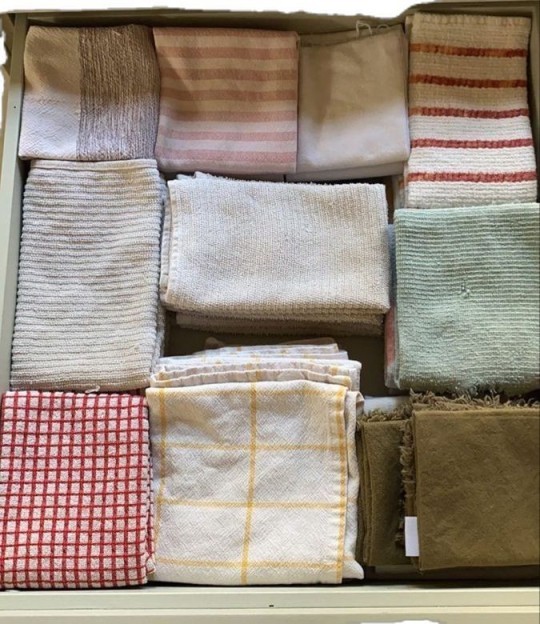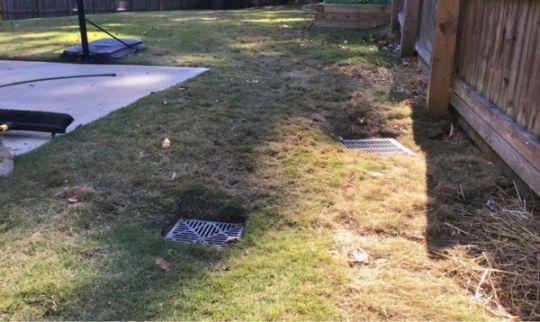#Property Drainage System
Explore tagged Tumblr posts
Text

To prevent flooding and maintain property stability, specialized drainage solutions in Sandy Springs offer effective water management. Residential drainage in Sandy Springs provides targeted services that address drainage challenges, ensuring long-term protection and the longevity of outdoor spaces. Visit https://erosionmanagementservices.com/service-areas/erosion-control-in-sandy-springs-ga/ for more details.
#residential drainage sandy springs#water management#property stability#flood prevention#foundation protection#landscape health#drainage solutions#erosion control#efficient systems#long-lasting results
0 notes
Text
"The Lower Ninth Ward of New Orleans has recently witnessed an incredible eco-renaissance following decades of damage and neglect.
Led by a local community development group, a 40-acre wetlands park has been restored to glories past with hundreds of local trees that attract over a hundred species of birds, plus joggers, picnickers, and nature lovers besides.
The story begins with Rashida Ferdinand, founder of Sankofa Community Development Corporation (CDC). Growing up in this historic part of New Orleans, where Black homeownership thrived, where Fats Domino was born, and where locals routinely went out into the wetlands to catch fish and crustaceans, she watched as it suffered from years of neglect.
Poor drainage, ruined roads, illegal trash dumping, and unmitigated damage from hurricanes slowly wasted the wetland away until it was a derelict eyesore.
In the name of restoring this wild heritage indicative of the culture in the Lower Ninth, and in order to protect her communities from flooding, Ferdinand founded the Sankofa CDC, and in 2014 entered into an agreement with the City of New Orleans for the restoration of Sankofa—a 40-acre section of neglected wetlands in the heart of the Lower Ninth.
The loss of Sankofa’s potential to dampen flooding from storms meant that over the years dozens of houses and properties were flooded and damaged beyond the ability of the inhabitants to recover. Forced out by a combination of nature’s fury and government failure, the cultural heritage of the community was receding along with the floodwaters.
Ferdinand knew that restoring natural flood barriers like Sankofa was key to protecting her community.
“Hurricane protection is a major concern in the community, but there’s a lack of trust in the infrastructure systems that are supposed to protect us,” Ferdinand told the Audubon Society.
Today, Sankofa Wetlands Park is a sight to behold. Hiking trails snake through a smattering of ponds and creeks, where bald cypresses and water tupelo trees continue to grow and cling to the ground even during storms. Picnic benches have appeared, wheelchair-accessible trails connect sections of the park to parts of the Lower Ninth, and local businesses are seeing more visitors.
It needed a lot of work though. Thousands of invasive tallow trees had to be uprooted. 27,000 cubic meters of illegally dumped trash compacted into the dirt had to be removed. A 60-year-old canal dug by the US Army Corps of Engineers had to be disconnected, and all new native flora had to be planted by hand.
Audubon says that Ferdinand routinely can’t believe her eyes when she looks at the transformation of Sankofa into its current state.
“Seeing butterflies, birds, and other pollinators in the park is a sign of a healthy ecosystem,” she says. “All we had to do was create the right conditions.”
Slated for official completion in 2025 with an outdoor amphitheater, interpretive signage, and additional trails, Ferdinand and the CDC have their eyes set on an even larger area of wetlands to the north of Sankofa.
Along the way, Ferdinand and the CDC attracted many helping hands, and entered into many partnerships, But the catalyst for change arose from the spirit and determination of one woman in the right place at the right time, for the benefit of hundreds in this historic heart of a historic city."
-via Good News Network, September 17, 2024
#new orleans#louisiana#nola#united states#wildlife#wetlands#ecology#ecological restoration#conservation#good news#hope
3K notes
·
View notes
Text
Personal associations/interpretations of the dark/mystical houses (4th, 6th, 8th, 12th)


4th house
twisted tree roots, cultural practices, heirlooms, photo albums, inherited features, traditions, the mother, past lives, generational trauma, picture books, garden beds, childhood homes, ancestor altars, hand written recipe books, hearth, squeaky wooden floorboards, genealogy archives, caves, oak trees, baby wrap carriers, emotional security, cultural heritage, building foundations, photo albums, genetics, laundry lines, swing sets, property, mines, crops, sanctuaries, the chest and heart, home steads, fields, farms, root cellars, harvests, pots on stoves, brooms, backyards, agriculture, vines on trellises, handmade blankets, grandparents house, laundry baskets, attachment styles, singing lullabies, history, deep emotions, instincts, the unconscious, summer, waxing moon, vase of flowers, bath time, picking berries, celebrating holidays, chicken coops, older sisters, family gatherings, stone paths, forest walks, ancient structures/buildings, ancestral languages, cupboards, staying in



6th house
vitamins and supplements, morning routines, pharmacies, tasks and lists, doctors offices, health food stores, stomach medicine, hygiene practices, journals and planners, schedules, herbal teas, personal rituals, emergency kits, dog walks, lymphatic drainage, caregiving, donating blood, examinations and checkups, meditation, colour coordination, sticky notes, gastrointestinal problems, folded laundry, labels on everything, retirement homes, hand washing, braided hair, herb gardens, filing cabinets, face masks, kombucha, detailed diagrams, volunteer work, medicine cabinets, cleaning supplies, shelves, acts of service, skin care, organic linen, gauze and stitches, stress-induced illnesses, essential oil/herb baths, house plants, instructions, repetition, holistic medicine, giving advice, yoga studios, "gut feeling," bone broth



8th house
altars, divination, near death experiences, candle wax, feeling crushed by a heavy weight, grave dirt, red/dim lighting, funerals, double income, control, the underworld, cheques, insurance, heirlooms, ghost sightings, power imbalances, crime documentaries, ouroboros, bank accounts, grief and loss, shadow work, the womb, manipulation, scrying mirrors, Russian nesting dolls, keys, mortuaries, tests from the universe, pendulums, crime scene tape, the phoenix, projections, credit scores, animal bones on a forest floor, blood stained sheets, metaphysical shops, spiritual attacks, deep emotions, snakes, dead flowers, late autumn, wedding veils, envelopes, full moon, muddy boots, shadows at the corners of your vision, scarab beetles, inner processing, experiencing crisis, inherited possessions, natural disasters, sexual trauma, psychological studies, ancestral connections, cracked dolls, veil between realms, mental illnesses, deep connections, intimacy, reincarnation, torture devices, keys, whirlpools, the sound of sirens, unconscious fears, intense first impressions, pushing limits, feeling bound, scratches on walls, ten of swords


12th house
abandoned places, liminal spaces, long winters, shadowy figures, reoccurring dreams, repeated patterns, fog-filled forests, self analysation, inner worlds, cave systems, unfinished basements, hallucinations, solitary confinement, empty parking garages, spiral staircases, substance abuse, trapped in purgatory, hidden beneath the surface, maladaptive daydreaming, hospital hallways, confines of society, waning moon, moths, wandering aimlessly, disconnection from the world, psych wards, healing others, tired eyes or dark circles, chronic mental illness, suppression, addictions, hiding places, overnight shifts, unexplainable experiences, past life karma, exhaustion, cobwebs, others projections, catacombs, bird cages, premonitions in dreams, prescription bottles, self destructive patterns, late night walks, misty lakes, the feeling of walking out of the movie theater at night, identity crises, blurred faces, empty public transport, astral projection, comas, diary entries, dissociative episodes, shape shifting, generational trauma, observing people, mirrors, padded rooms, the afterlife, chain link fences, paradoxes, feeling misunderstood, repression or memory loss, hikikomori, the freeze response, disappearance, waiting rooms
#astrology#astrology community#astro tumblr#astro notes#astroblr#astrology aesthetic#4th house#6th house#8th house#12th house
249 notes
·
View notes
Text
Birds Sing Anew After Residents of New Orleans Ninth Ward Restore 40-Acre Wetland to Historic Glory https://www.goodnewsnetwork.org/birds-sing-anew-from-within-40-acre-wetland-restored-by-residents-of-n-orleans-historic-lower-ninth/

The Lower Ninth Ward of New Orleans has recently witnessed an incredible eco-renaissance following decades of damage and neglect.
Led by a local community development group, a 40-acre wetlands park has been restored to glories past with hundreds of local trees that attract over a hundred species of birds, plus joggers, picnickers, and nature lovers besides.
The story begins with Rashida Ferdinand, founder of Sankofa Community Development Corporation (CDC). Growing up in this historic part of New Orleans, where Black homeownership thrived, where Fats Domino was born, and where locals routinely went out into the wetlands to catch fish and crustaceans, she watched as it suffered from years of neglect.
Poor drainage, ruined roads, illegal trash dumping, and unmitigated damage from hurricanes slowly wasted the wetland away until it was a derelict eyesore.
In the name of restoring this wild heritage indicative of the culture in the Lower Ninth, and in order to protect her communities from flooding, Ferdinand founded the Sankofa CDC, and in 2014 entered into an agreement with the City of New Orleans for the restoration of Sankofa—a 40-acre section of neglected wetlands in the heart of the Lower Ninth.
The loss of Sankofa’s potential to dampen flooding from storms meant that over the years dozens of houses and properties were flooded and damaged beyond the ability of the inhabitants to recover. Forced out by a combination of nature’s fury and government failure, the cultural heritage of the community was receding along with the floodwaters.
Ferdinand knew that restoring natural flood barriers like Sankofa was key to protecting her community.
“Hurricane protection is a major concern in the community, but there’s a lack of trust in the infrastructure systems that are supposed to protect us,” Ferdinand told the Audubon Society.
Today, Sankofa Wetlands Park is a sight to behold. Hiking trails snake through a smattering of ponds and creeks, where bald cypresses and water tupelo trees continue to grow and cling to the ground even during storms. Picnic benches have appeared, wheelchair-accessible trails connect sections of the park to parts of the Lower Ninth, and local businesses are seeing more visitors.
Visiting birders have recorded sightings of over 100 species of songbirds, ducks, near-shore waders of all kinds, egrets, and herons, and the park also acts as a home and refuge for otters, beavers, and a variety of amphibians and reptiles.
It needed a lot of work though. Thousands of invasive tallow trees had to be uprooted. 27,000 cubic meters of illegally dumped trash compacted into the dirt had to be removed. A 60-year-old canal dug by the US Army Corps of Engineers had to be disconnected, and all new native flora had to be planted by hand.
Audubon says that Ferdinand routinely can’t believe her eyes when she looks at the transformation of Sankofa into its current state.
“Seeing butterflies, birds, and other pollinators in the park is a sign of a healthy ecosystem,” she says. “All we had to do was create the right conditions.”
Slated for official completion in 2025 with an outdoor amphitheater, interpretive signage, and additional trails, Ferdinand and the CDC have their eyes set on an even larger area of wetlands to the north of Sankofa.
Along the way, Ferdinand and the CDC attracted many helping hands, and entered into many partnerships, But the catalyst for change arose from the spirit and determination of one woman in the right place at the right time, for the benefit of hundreds in this historic heart of a historic city.
#new orleans#good news#environmentalism#science#environment#nature#usa#restoration#rewilding#wetlands#conservation#climate change#climate crisis#animals#birds#trees#disaster prevention and preparedness
183 notes
·
View notes
Note
Hello, bitches! I don't think I saw this in the renter's master post, but how does one go about breaking a lease in the least financially ruinous way possible? My apartment flooded for the 3rd time in 12 months due to an improper drainage system, and I am FED UP. I have family telling me to sue over it, but I'd be content if they let me break the lease without fees or penalties.
If your apartment keeps flooding and your landlord has not fixed the problem... then your LANDLORD HAS ALREADY BROKEN YOUR LEASE.
A lease is a legal contract. Which means the landlord AND tenant both have responsibilities in order to keep the contract valid. There is usually language in there about the landlord keeping the unit in good maintenance. Constant flooding is NOT good maintenance. And if your property has been damaged by the flooding, the landlord could actually owe YOU, either for temporary housing or replacement of property.
So go read your lease, find the clause about maintenance, and take it to your landlord and say "According to this clause right here, you're in violation of our rental agreement. Therefore, I am moving out without penalty. If you'd like to discuss this, I'll have my lawyer get in touch." (Note: not everyone can afford a lawyer, but if you know anyone even tangentially related to a law firm, use the line about the lawyer. My husband's uncle and aunt are lawyers and the one time I used this line to resolve a labor dispute, it scared the bastard so much that they stopped their bullshit and paid me for my work with no further argument.)
Lastly: we are not infallible. Your state government website should have a section on tenant's rights. Look up this information to see if there are any other protections you can take advantage of before going nuclear on your shitty landlord.
The Rent Is Too Damn High: The Affordable Housing Crisis, Explained
Ask the Bitches: Why Are Painted Mason Jars the Internet's Only Solution to My Tiny Apartment Woes?
If we just helped you out, tip us!
85 notes
·
View notes
Text
Sage
Salvia officinalis
Known as: Common sage, green sage, garden sage, meadow sage, culinary sage & true sage
Related plants: A member of the of the mint family Lamiaceae that includes plants such as basil, mint, rosemary, sage, savory, marjoram, oregano, hyssop, thyme, lavender & perilla as well as catnip, salvia, bee balm, wild dagga & oriental motherwort.
Parts used: Leaves & stems
Habitat and cultivation: This evergreen subshrub is native to the Mediterranean region with it's mild to cool, rainy winters & warm to hot, dry summers.
Plant type: Perennial
Region: Zone 5-8 your sage will grow as a hardy perennial. However in the humid climates of zones 9 & farther south, sage is usually an annual, as it does not easily tolerate summer heat & humidity.
Harvest: Harvest lightly in the first year to ensure the plant grows fully. After the first year, be sure to leave a few stalks so that the plant can rejuvenate in the future & If fully established, one plant can be harvested up to three times in one season.
Planting tips: Plant in full sun & plants should be two feet apart. Sage should be planted in well draining soil like a sandy or loamy soil with good drainage. Wet soils can cause rot and be fatal to the plant. The easiest and best way to start sage is from a small plant, but you can also sow seeds up to two weeks before the last frost date.
Medicinal information: Taking sage by mouth seems to improve memory and thinking skills in healthy adults & taking it for four weeks can improve menopause symptoms. One study found that drinking tea made from sage both raised antioxidant defenses and lowered LDL or “bad” cholesterol. It also could be used for pain after surgery, lung cancer, sore throat, sunburn, and many other conditions. Sage leaves have been used in traditional medicine as a treatment for diabetes.
Cautions: Sage is possibly unsafe when taken in high doses or for a long time due to a chemical called thujone. Too much thujone can cause seizures and damage the liver and nervous system. Thujone can also bring on a menstrual period, which could cause a miscarriage so taking sage during pregnancy is not advised. It may also reduce milk production while chest feeding.
Magickal properties
Gender: Masculine
Planet: Jupiter
Element: Air
Deities: Chiron, Consus, Jupiter, Obatala & Zeus
Magickal uses:
• Use the leaves for tea for communion of Jupiter or in any workings involved with the planet & grounding
• Burn to find clarity & wisdom while asking difficult questions
• Write a wish on Sage leaf and burn it to release your intention
• Place a Sage leaf in your wallet to attract money
• Include in feminine fertility spells to boost your chances of success
• Add Sage oil incense or herbs to any spell to temper the results with wisdom
• Burn during a funeral & memorial to facilitate healthy grief and bonding with the spirits of those who passed on
• Use spells to alleviate grief & steady emotions
• Put in a satchet to carry from protection from negative energies & influences
• Burn to cleanse your home, clear negative energies & increase your intuition
• Rub sage on your forehead before divination to increase the accuracy of your results
• Pick twelve leaves at midnight on Christmas Eve to see a vision of your future husband(without damaging the bush)
• Write your desire on a sage leafe & place it under your pillow for three days. If you dream of your desire, it will soon materialize. If not, bury the sage.

#herb of the week#sage#herbalism#green sage#witchblr#wiccablr#paganblr#witch tumblr#witches of tumblr#witch community#witchcraft#book of shadows#grimoire#spellbook#spells#spellcraft#green witchery#green witch#magical herbs#beginner witch#baby witch#witch tips#baby witch tips#beginner witch tips#witch#spellwork#witchy things#GreenWitchcrafts#correspondence#witchcore
143 notes
·
View notes
Text

Farmers across the UK have been helping to clear debris from roads following Storm Bert and Storm Conall. Thank you.
The lads and ladies at my Dorset farm have been very busy. Not only have they helped re-open nearby rural roads, they have also assisted a number of neighbouring properties, including a horse farm which suffered significant damage. On top of this, they have been making temporary repairs to a few of our own farm buildings. None of our livestock have suffered injury. How the heavy rain affected our early sown grain crops will be assessed tomorrow.
Today (27th November2024) the very heavy rain of Storm Conall affected the area around my home in Kent. It is the worst road flooding I have witnessed for several years. The village of Sundridge was badly hit... with flood water from the River Darent to the north, and the run off water of sodden fields in the Greensand Ridge to the south. The main A25 road between Westerham and Sevenoaks was closed for a time. And the railway line between Redhill and Tonbridge was closed due to flooding.
My adopted cat's former home also suffered some flood damage. The property is downhill from my estate. After I installed a drainage system to stop my wine cellar from flooding in 1988/89, my elderly neighbour's kitchen would often be flooded. I did not find out about this until 2020... and I still feel very guilty! In 2021, I paid to have my neighbour's garden landscaped so the excess rainwater would be diverted away from her front door. It didn't work today! (Luckily the house is currently unoccupied.)
We have suffered less than many other people have. My heart goes out to everybody who has had to leave their homes due to the horrendous weather over the last week.
10 notes
·
View notes
Text
To make a pond + Earthworks!
I've been enamored by the idea that I could build my own pond in the future, but when I started looking into it (typing 'how to build a pond into youtube'), all people did was put a big plastic tarp into a landscape and add water inside. That wasn't what I wanted. I wasn't about to bring a plastic tarp in my environment, and it was obvious that once the tarp gets damaged and punctured, the water would drain into the soil and the pond would be no more. That's no fun.
Unable to immediately find a better way, I turned to my own brain to figure this out. There were natural ponds in the world, and somehow they didn't need a tarp to hold all that water in. Artificial lakes existed, and for sure there weren't any tarps holding the water in. Rivers don't drain easily, and they usually have a lot of sand on the bottom – but sand is a very drainable material, so that's probably not it.
I stumbled upon an interesting piece of information when I was learning about rocks. By some definitions, ice is also a type of rock, so there was a lesson on icebergs. I found out there that sometimes icebergs split apart and travel in the water, and when a huge chonk ends up in a non-icy landscape, it eventually melts and it turns into a lake. There were pictures of lakes that looked like they had no business being in that landscape, but were there because an iceberg had melted there. The water didn't drain or ran off, why? I assumed it was because the iceberg was so heavy it compacted the soil underneath, and the compacted clay was enough to hold the water in.
So I started playing with the idea that if I locate a soil with high percentage of clay, and then dig a pond, and then line the bottom with the highest-density clay I can find, and then I redirect all water from the landscape to go towards that pond, maybe I could make a little pond in there. Possibly it would dry out during the summer but for the rest of year, having a natural pond would be very nice. I wasn't sure if this logic would hold but then I also couldn't see why not. Clay doesn't drain easily and there's lots of it deep underground. I would grab a shovel and try.
I got an additional piece of information reading a book about collecting and filtering rainwater to make it drinkable; the book recommended before you do anything about this, you need to learn about 'Earthworks', a system of modifying the earth's surface to keep as much water in as possible, and to redirect it to where you want it. I immediately liked this, because I had already planned to do that, but I was interested in tried and true methods. So I looked it up, and one of the first videos I've found, was of people deciding to make a natural pond in the forest. They found the most dense clay-rich ground, dug to see if it was super dense and non-draining deep in. Then they created a dam to stop water from flowing past the pond, and redirected all rainwater that would fall into the forest, towards the pond. And it worked. It filled out within a month or two. It wasn't draining away.
I felt so vindicated, the logic I had put together in my head was real and I could see how other people did it in real life! And I learned about berms and swales; they're methods of making your ground uneven, so it could take in and hold more rainwater. Berms are little hills you make that have good drainage, and swales are shallow canals you make inbetween the hills; they hold the rainwater, stop it from flowing away from your property, and redirect it to where you want it to, for instance to irrigate a garden, fill a pond, or to water a big tree you want to grow.
The methods of keeping rainwater from evaporating are currently relevant, because the climate is getting unstable, and rain is no longer as consistent as it has been in the past. I've noticed that we now get tons of rain in the spring, winter and fall, but next to none in the summer, creating a drought. The forests and the animals feel it too; they struggle to survive the summer, and a lot of plants and animals die from lack of hydration, which they didn't need to deal with beforehand. There's also less ground covered by old resilient trees and foliage that keeps the water in the landscape; clean cutting forests means dry ground, water evaporating, streams and canals drying up, trees drying up because of no water supply.
The people who were building a pond in the forest were not doing it for fun and giggles; they noticed the natural streams of the forests have dried up as a result of cut areas and lack of consistent rain. The forest was in danger of drying up. So by building a system of swales (or trenches) to redirect rainwater, and ponds to store it, they've managed to revitalize parts of the forest. The forest around the pond was visibly greener within months, wildlife was multiplying around the pond where it could get water, new flowers and native plants were flourishing next to the pond.
Slightly modifying the landscape to keep water in is something people do to prevent the spread of deserts; digging half-moon shaped holes in the ground to hold water has enabled trees to grow even in the driest, sun-heated areas. I've been fascinated by the methods of growing trees in the desert! And right now we need to make sure other livable green areas don't start turning into deserts, because the climate is threatening it, and the animals are unlikely to survive it all on their own.
And if you build a little pond, you're gonna have more birds in your backyard. There's gonna be little frogs and turtles and tiny critters coming to drink from your pond. Maybe a little lizard or a snake. You're gonna be able to plant flowers around it, your trees will be happy, and if you want a great big willow, she's going to enjoy that water too, and purify it with her roots. I'm still putting it together in my brain if I could make a little swampy area and plant rice in it, that would be the ultimate success.
#earthworks#permaculture#pond#diy pond making#clay pond#environmental#learning about nature#rainwater#collecting rainwater#rain#preserving rain#making livable landscapes in the time of climate change
10 notes
·
View notes
Text
Can You Install Gutters on a Residential Metal Roof?
If you’re considering upgrading your home with a residential metal roof, you’re likely wondering about the best ways to maintain it. One question is whether you can install gutters on a metal roof. Well, you’re in the right place! In this article, we'll dive into the topic, discussing everything you need to know about gutters and residential metal roofing.
Understanding Residential Metal Roofing
Residential metal roofing has gained popularity for several good reasons. First, it’s known for its durability, often lasting over 30 years with minimal maintenance. Second, it comes in various styles and colors, making it an attractive option for homeowners. However, like any roofing system, it requires proper installation and maintenance to maximize lifespan.
Why You Need Gutters
You may wonder why gutters are essential. Gutters channel rainwater away from your home’s foundation, preventing water damage and erosion. Without proper drainage, water can pool around your home, leading to various issues, such as mold growth and structural damage. Installing gutters can be as important for homes with residential metal roofing as for homes with traditional roofing materials.
Installing Gutters on a Residential Metal Roof
The Installation Process
The process differs slightly from traditional roofs when installing gutters on a residential metal roof. It’s important to consider the roof’s slope, the type of metal material, and the overall design of your home. Before starting the project, here are a few steps you should follow:
Choose the Right Gutter System: Several gutter systems are available, including K-style, half-round, and seamless gutters. Each type has benefits and drawbacks, so choose one that suits your home’s style and needs.
Select Quality Materials: Consider using materials compatible with your metal roof. Aluminum is a popular choice due to its lightweight and rust-resistant properties.
Hire Professionals or DIY: While installing gutters may seem straightforward, hiring professionals specializing in residential metal roofing can ensure a proper installation. If you choose to do it yourself, follow manufacturer guidelines carefully.
Tips for a Successful Installation
Here are some helpful tips to ensure your gutters are installed effectively:
Ensure Proper Slope: Gutters should slope towards the downspouts to allow water to flow freely. A slope of about 1 inch for every 10 feet of gutter length is generally recommended.
Secure Anchors: Use specialized brackets designed for metal roofs to prevent your gutters from becoming loose over time.
Consider Gutter Guards: Installing gutter guards can help keep debris out, reducing the need for frequent cleaning and maintenance.
Maintenance Tips for Gutters on Residential Metal Roofing
After installing gutters, it’s essential to keep them well-maintained. Here are some practical tips to help you:
Regular Cleaning
Cleaning your gutters at least twice a year is vital, especially during spring and fall when leaves and debris accumulate. If trees surround your home, you may need to clean them more frequently. Clogged gutters can lead to water pooling, which can corrode your gutters and your metal roofing over time.
Watch for Overflows
After heavy rain or storms, check for any water overflow from your gutters. This could indicate a blockage or a problem with the installation. Addressing these issues promptly can prevent damage to your home’s foundation.
Trim Overhanging Branches
It is a good practice to trim tree branches away from your roof. Overhanging branches can scratch your metal roof and allow debris to accumulate in your gutters. Ideally, branches should be at least six inches away from your roof to minimize potential damage.
Common Challenges with Gutters and Residential Metal Roofing
Ice Dams in Winter
If you live in an area that experiences harsh winters, ice dams can be a concern. These occur when warm air from your home melts snow on your roof, refreezing at the eaves and causing ice to build up. To prevent ice dams, ensure your gutters are clean and debris-free, and consider installing heating cables if necessary.
Rust and Corrosion
Although metal roofing is designed to withstand the elements, improper installation or maintenance can lead to rust and corrosion. Ensuring your gutters are well-installed and regularly maintained can help prevent these issues.
When to Seek Professional Help
While DIY projects can be rewarding, some situations call for professional assistance. If you’re unsure about the installation process or encounter issues like extensive rust or structural damage, it’s best to consult experts. Professionals can assess your residential metal roofing system and provide the necessary repairs and maintenance.
In conclusion, you can install gutters on a residential metal roof. With proper planning and maintenance, gutters can enhance the efficiency and longevity of your roofing system. Remember to prioritize regular cleaning, monitor for blockages, and trim any overhanging branches to keep your gutters functioning well.
If you're considering upgrading your home with energy-efficient roofing solutions or need assistance with your current system, visit Lastime Exteriors. They offer services tailored to enhance your home’s performance and aesthetic appeal. Don’t wait—take the first step toward a better roofing solution today!
7 notes
·
View notes
Text
Can Residential Metal Roofing Be Installed During Rainy Weather?
When considering a new roof for your home, you might have many questions swirling in your mind. One of the most pressing queries could be: “Can I install residential metal roofing during rainy weather?” If you live in a region that experiences frequent rain, the thought of installing a roof amid wet conditions might seem daunting. In this article, we’ll explore the ins and outs of installing residential metal roofing during rainy weather, helping you make an informed decision that’s right for your home.
Understanding Residential Metal Roofing
Residential metal roofing has gained popularity for many reasons. Its durability, weather resistance, and low maintenance requirements make it an attractive option for homeowners. But what happens when the weather isn’t cooperating during installation? Let’s delve deeper into the factors that come into play.
The Basics of Installation Timing
While installing a roof in the rain isn’t ideal, it is not impossible. Many roofing professionals are equipped to handle projects even in less-than-perfect weather conditions. Before proceeding, it’s essential to assess the severity of the rainfall and the preparedness of the roofing team.
Considerations for Installing Residential Metal Roofing in Rainy Weather
Safety First: Working on a roof during rain can increase the risk of accidents due to slippery surfaces. A professional roofing team will evaluate conditions and prioritize safety, ensuring they have the right equipment and techniques to minimize risks.
Material Handling: Metal roofing materials can be slippery when wet, leading to potential hazards during installation. Skilled roofers will know how to manage these materials safely, even in moist conditions.
Water Management: One of the advantages of residential metal roofing is its excellent drainage system. Metal roofs are designed to channel water away effectively, which can mitigate concerns during installation. However, if the drainage system is obstructed or the roof isn’t fully installed, water could accumulate in certain areas, leading to challenges.
Benefits of Residential Metal Roofing in Rainy Climates
It’s worth noting that residential metal roofing is particularly beneficial in rainy climates. The following advantages make it an excellent choice, regardless of the weather during installation:
Superior Waterproofing Properties: Metal roofing’s watertight barrier effectively channels rainwater away, protecting your home from leaks and water damage.
Resistance to Mould and Mildew: Unlike traditional roofing materials, metal roofs resist moisture absorption, reducing mold and mildew growth. risk
Longevity and Durability: Metal roofs are designed to withstand the elements, including heavy rain, without cracking or warping. This longevity can save you money in the long run.
What to Expect During the Installation Process
If you decide to proceed with the installation of residential metal roofing during rainy weather, here’s what you can typically expect:
Preparation and Planning: Before starting the project, the roofing contractor will likely thoroughly assess the weather conditions and the condition of your roof.
Efficient Installation Techniques: Professional roofers will use specific methods for efficient installation even in the rain. This includes using protective coverings and tools that help manage water flow.
Communication is Key: An experienced roofing contractor will keep you informed throughout the process, discussing any weather-related challenges and adjustments to the timeline as necessary.
Alternatives and Delays
If the rain is too heavy or consistent, postpone installation. Here are some alternatives to consider:
Scheduling for Fair Weather: If your roof doesn’t need immediate attention, wait for a dry spell to ensure optimal installation conditions.
Temporary Solutions: If you have leaks or urgent repairs, your contractor may suggest temporary fixes until more favorable weather arrives.
Long-Term Considerations
Once your residential metal roofing is installed, you’ll likely appreciate its many benefits, especially in rainy climates. Here are some long-term considerations:
Regular Maintenance: While metal roofs require less maintenance than traditional materials, periodic checks can help keep your roof in top condition.
Enhanced Property Value: Quality roofing can increase a property’s market value, making it a wise long-term investment.
Energy Efficiency: Many metal roofing options come with energy-efficient properties, helping to reduce your heating and cooling costs.
Shield Your Home with Confidence
In summary, while installing residential metal roofing during rainy weather is possible, it comes with certain considerations that require careful planning and execution. The benefits of metal roofs in rainy climates far outweigh the challenges, making them an excellent choice for homeowners.
If you’re ready to explore your options for residential metal roofing, don’t hesitate to contact the professionals. Visit Lastime Exteriors to discover our range of energy-efficient roofing solutions tailored to your home’s needs. Let’s make your roof a sturdy protector against the elements!
7 notes
·
View notes
Text
Weep Holes: An Essential Component For Structural Integrity

The world of construction methodologies is vast, dynamic, and continuously evolving. Among the myriad of procedures and mechanisms crucial to the development of robust structures, a particularly crucial yet often overlooked feature is the ‘weep hole.’ In this blog, we delve deeper into what weep holes are, focus mainly on their application in cinder block structures, reasons for their installation near the footing, and the benefits that they provide related to relieving water trapped within a structure.
To begin with, let’s establish what Weep Holes are. Weep holes, as the name suggests give an image of something that exudes, seeps out, or, indeed, weeps. In construction parlance, they are purposely drilled in a structure to allow the movement of water or to let it escape from within.
Though these holes can be integrated into several types of structural system, their use is widely popular in cinder block constructions. Cinder blocks, also known as concrete masonry units, are commonly used in residential as well as commercial construction due to their affordability, strength, and insulation properties. Their design usually involves hollow cores, or cavities, that can unintentionally trap water within. Whether it’s from groundwater, landscape irrigation, or rainfall, the cinder block can host this water, giving birth to many potential issues such as mold, mildew, efflorescence, or even structural failure if water freezes and expands.
Therefore, to alleviate these concerns, weep holes are drilled into the cinder blocks, typically in the bottom row and near the footing. Placed lower down because water tends to flow to the lowest point due to gravity, these openings play a vital role in the overall health and longevity of the structure.
When water is present in the hollow cavities of the cinder block, the weep holes facilitate an escape route. But it isn’t just about aiding drainage; these holes also play an essential part in the structure’s ventilation, helping trapped moisture to dry up more quickly.
One might wonder–why near the footing? The footing of a building is the lowest part of the structure, usually installed below ground level. For blocks near the footing, water accumulation is most likely due to their proximity to the ground. To prevent rising dampness creeping up into the structure and ensure optimal effectiveness, weep holes are strategically drilled near the footing.
One concern that often arises about weep holes is the threat of small creatures or pests entering through them. To prevent this, weep holes are generally covered with plastic, steel, or another type of mesh to allow water escape but deter critters.
Let’s sum up the importance of weep holes: They are not a construction afterthought but an essential design feature engineered to prolong and conserve the structural integrity of cinder block structures, whether they be a garden wall, chicken coop, house, or commercial building. By simultaneously promoting ventilation and facilitating the drainage of trapped water within the cinder blocks’ hollow cavities, weep holes help to prevent the onset of undesirable moisture issues, water damage, and structural instability.
So the next time you come across some random, small holes in a structure, remember, they aren’t gaps in design or construction; they’re mitigating water damage one drop at a time. This is the importance of an often overlooked, yet vital construction element – the weep hole.
Tagged Essential Component For Structural Integrity, Structural Integrity
#Essential Component For Structural Integrity#Structural Integrity#foundation repair#foundation solutions#foundation contractor#foundation experts#foundation repair solutions#foundation services#residential foundation repair services#foundation repair near me#foundation solution#signs of foundation problems
7 notes
·
View notes
Text

Effectively managing water flow and drainage solutions in Roswell helps prevent landscape damage and erosion. Yard drainage Roswell services focus on resolving water management challenges with precision, ensuring long-term protection and functionality for both residential and commercial properties. Visit https://erosionmanagementservices.com/service-areas/erosion-control-roswell-ga/ for more details.
#yard drainage roswell#water flow management#flood prevention#soil erosion control#property protection#healthy landscapes#drainage solutions#outdoor safety#functional systems#long-term efficiency
0 notes
Text
After the floods in the state of Rio Grande do Sul, the most vulnerable population still deals with the consequences of the tragedy
Garbage accumulates on the streets of the city of Porto Alegre

The floods in Porto Alegre, the capital city of Rio Grande do Sul, revealed the serious consequences of political choices. The lack of urban planning and investment in adequate drainage systems contributed to the city's vulnerability, causing one of the worst climatic tragedies in Brazilian history.
The neoliberal agenda the municipal and state governments adopted has shown itself to be a hygienist project, in which state policies address mainly the upper and middle classes, while the poorest are left to fend for themselves. It's common to see mountains of garbage that haven't yet been removed from the streets, places where there are still waterlogged and, above all, a population that, in the long term, will suffer the consequences of these political choices.
The population living in the surrounding areas of Porto Alegre faces problems due to the accumulation of garbage, exposure to various forms of contamination and disease, and finds it difficult to arrive at their workplaces. With trains still not working and the accumulation of water in the stations, many people have no access to their sources of income.
In addition, many of these families welcome relatives and friends into their homes. Reports of these difficulties are frequent: people who have lost everything, including their income, can't even access publicized benefits because of bureaucracy. Data shows that 60% of residents in the metropolitan region of Porto Alegre have had their income affected. Of all the capital’s 96 neighborhoods, 46 were affected, directly harming 157,000 people and damaging 39,000 properties, according to a survey by Rio Grande do Sul’s registry office.
Continue reading.
#brazil#brazilian politics#politics#environmental justice#rio grande do sul floods 2024#image description in alt#mod nise da silveira
12 notes
·
View notes
Text
The felling of a tree should be carefully considered, whether it is to build a road or a house or because the leaves pollute the roof and block the drainage system. Trees offer numerous benefits that should be considered:
🌳 **CO2 absorption and oxygen production:** One tree absorbs about 22 kg of CO2 per year and produces enough oxygen for two people. This contributes significantly to improving air quality.
🌿 **Soil stabilization:** With its deep roots, a tree stabilizes the soil and prevents erosion. The roots improve the soil structure and increase the water retention capacity of the soil.
🌳 **Climate regulation:** Trees reflect and absorb some solar radiation, which helps to cool the environment. A single tree can have the cooling effect of ten air conditioners.
🌿 **Cloud formation and precipitation:** Through evaporation, trees contribute to cloud formation and thus have a positive influence on the local microclimate and precipitation.
🌳 **Soil fertility:** Leaves that fall to the ground decompose and serve as food for the soil. This promotes soil fertility and supports the growth of other plants.
🌿 **Nutrient cycling:** Trees provide sugars to the mycelium in exchange for nutrients, which promotes soil life and supports ecosystem health.
🌳 **Air purification:** Trees absorb dust and pollutants such as nitrogen oxides and sulphur dioxide, which significantly improves air quality.
🌿 **Habitat:** Trees provide habitat and food for a variety of animals, including birds, insects and rodents, thus promoting biodiversity.
🌳 **Sound and visual protection:** Trees can act as a natural sound and visual barrier, which is particularly beneficial in urban areas.
🌿 **Shade and protection:** Trees provide shade and protection from UV radiation, which pleasantly cools the local microclimate.
Additionally, it can be mentioned:
📊 **Economic benefits:** Urban trees can increase property values and reduce energy costs by providing natural cooling.
📈 **Health benefits:** Spending time near trees and green spaces reduces stress, improves mental health and promotes physical activity.
🌳🫶🏼🌳
**Conclusion:** In addition to CO2 reduction, a tree provides freshness, water and oxygen. Trees are an indispensable technology that can save us! Plant trees, plant hedges. 👍

9 notes
·
View notes
Text
youtube
Josh visits a steep riverside block in Perth where the owners have had to work around some interesting natural features.
Owner Andrew Boyne is an architect who enjoyed the challenge of creating a low-impact home on the battle-axe block, and he devoted 80% of the land to garden. He says the presence of fresh water in such a summer-dry climate as a blessing; “We can irrigate the whole garden all year.”
To level out the site, three terraces were created. This allows different planting conditions, with the edges of the terraces were raised to allow more arid species to grow there, by bringing them out of the water table.
Drainage is an issue because the water level is so high; soak wells were dug around the property to help dry it out, and elevating certain areas helped, too.
Any rain is collected through soak wells and then pushed through the main creek system that runs through the property.
The soak wells also direct the spring water to a number of water features, and from here they go via a waterfalls to the creek to a wetland.
More than 200 Western Australian plants have been used in the garden, with three areas representing three different WA regions.
Verticordia grandis has pride of place in a vertical concrete pipe that is visible from the main living space. Bull banksias and a Karri tree are other favourites.
Having huge picture windows helps connect them to the trees and plants when then connect them to place.
#gardening australia#solarpunk#australia#sustainable architecture#sustainable building#garden#gardening#terraces#soak wells#native plants#Youtube
6 notes
·
View notes
Text
What Are the Disadvantages of a Patio?
Patios are often celebrated as a must-have home feature, but let’s be honest—nothing is perfect. While they create a cozy outdoor space, offer a great spot for summer BBQs, and add value to a home, patios come with their fair share of downsides. If you’re considering one for your property, it’s worth looking at the other side of the coin.
So, what’s the catch? Here’s a breakdown of the potential drawbacks of having a patio.
High Maintenance and Upkeep
A patio might look stunning when it’s first installed, but keeping it that way takes effort. Dirt, debris, and stains build up fast—especially if your patio is made of porous materials like concrete or natural stone. And if you live in an area like South Bend, where the seasons change drastically, you’ll have to deal with:
Moss and algae growth – Shaded areas can turn into a slip hazard.
Cracking and wear – Freeze-thaw cycles cause concrete and stone to crack over time.
Weeds – If you have pavers, weeds love sneaking through the gaps.
If you’re not a fan of power washing, sealing, or regularly weeding between stones, a patio may feel more like a burden than a bonus.
Weather Dependency: The Big Mood Killer
Ever planned a perfect outdoor dinner only for the weather to ruin it? That’s the reality of owning a patio. Unlike enclosed spaces, patios offer zero protection from rain, wind, or extreme sun.
South Bend homeowners know that the Midwest’s unpredictable weather means you might only get to enjoy your patio for a few months before snow and rain take over. Sure, you could install a pergola or awning, but that’s another expense (and more maintenance).
Bottom line? If you don’t have a covered patio, Mother Nature decides when you can use it.
Installation Costs Add Up Fast
Building a patio isn’t exactly cheap. The cost depends on factors like size, materials, and design complexity, but even a modest patio can run several thousand dollars. And that’s just the beginning:
Custom designs (like stamped concrete or intricate paver patterns) drive up the price.
Drainage issues can mean additional costs for grading or installing a drainage system.
Furniture and décor – Because let’s face it, a bare patio isn’t inviting.
And if you decide later that you want a screened-in porch or sunroom instead? That’s another major renovation.
Comfort Issues: Too Hot, Too Cold, Too Buggy
A patio is only as enjoyable as the environment around it. Without proper shade, it can feel like a frying pan in the summer. In colder months, it’s just an empty space collecting leaves.
And let’s not forget the bugs. South Bend’s humid summers bring out mosquitoes, flies, and gnats. Unless you invest in citronella candles, bug zappers, or screened enclosures, you’ll spend half your time swatting away pests.
Safety Concerns: Slips, Trips, and Uneven Surfaces
If you’ve ever walked across a patio after a rainstorm, you know how slippery it can get. Certain materials—like smooth stone or tile—become hazards when wet.
Other risks?
Uneven pavers can shift over time, creating trip hazards.
Poorly constructed patios may not have proper drainage, leading to pooling water.
Children and pets can scrape their knees on rough surfaces or burn their paws on hot concrete.
If safety is a concern, you’ll want to choose materials wisely and stay on top of maintenance.
Can Reduce Lawn Space (Which Matters More Than You Think)
For families with kids or pets, every square foot of lawn matters. Installing a patio means giving up green space—something that could be a dealbreaker if you love gardening, playing with your dog, or watching the kids run around.
In some cases, homeowners regret adding a large patio when they realize they miss the flexibility of an open yard. Unlike grass, patios don’t absorb rainwater, which can also create runoff problems if not properly managed.
Not Always a Good Return on Investment (ROI)
Many homeowners assume that adding a patio will automatically boost their home’s resale value. While patios can be attractive to buyers, they don’t always translate to a higher selling price.
Why?
Some buyers may see the patio as extra maintenance.
If the patio is outdated or in poor condition, it can lower curb appeal.
Not every buyer values outdoor living space equally—especially in colder climates.
A well-maintained patio can add appeal, but it’s not a guaranteed way to increase property value.
Can Lead to Drainage Issues
Poorly planned patios can cause serious water problems. If your patio isn’t properly sloped, rainwater may pool on the surface or, worse, run toward your house. Over time, this can lead to foundation issues, erosion, or basement leaks.
This is why professional installation matters. A DIY patio might seem like a fun weekend project, but if drainage isn’t done correctly, you could be dealing with long-term water damage.
Limited Year-Round Use
Unlike an enclosed sunroom or screened porch, a patio is at the mercy of the seasons. If you want to use your outdoor space all year round, a simple patio won’t cut it.
Some homeowners try to extend patio season with:
Outdoor heaters – Adds warmth but can be costly.
Fire pits – Cozy but not a full solution in freezing weather.
Retractable screens – Helps with bugs but doesn’t block wind.
At some point, patios hit a usability limit—especially in places with harsh winters like South Bend.
Is a Patio Right for You?
Patios have plenty of perks, but they aren’t for everyone. If you’re looking for a low-maintenance, all-weather outdoor space, a sunroom or screened porch might be a better option.
For South Bend homeowners who love entertaining, don’t mind upkeep, and enjoy outdoor spaces, a patio can be a great addition—as long as you’re aware of the downsides.
Before making a decision, ask yourself:
Do I want a space I can use year-round?
Am I willing to handle the maintenance?
Will I actually use my patio enough to justify the cost?
If you’re unsure, consider speaking with a local contractor about other options like covered patios, pergolas, or enclosed porches.
Whatever you choose, make sure it fits your lifestyle—not just the latest home improvement trend.
7 notes
·
View notes